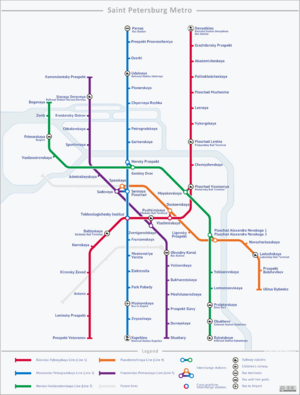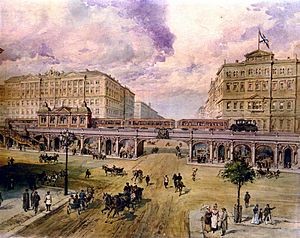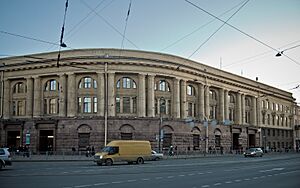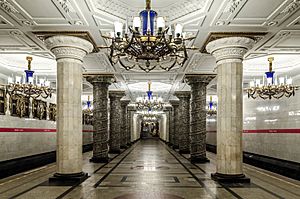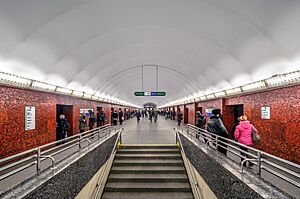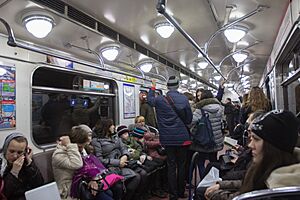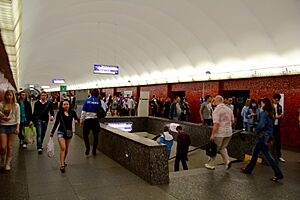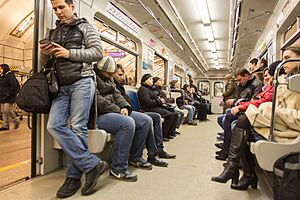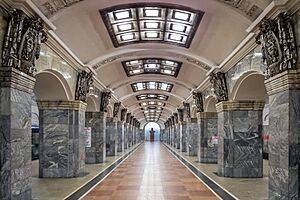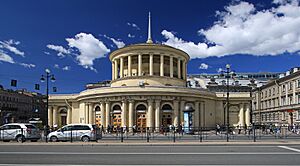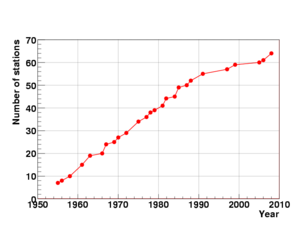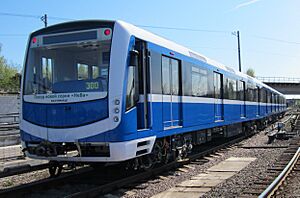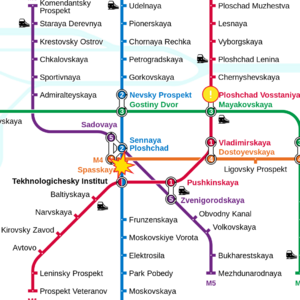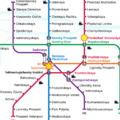Saint Petersburg Metro facts for kids
Quick facts for kids Saint Petersburg Metro |
|||
|---|---|---|---|
 |
|||
| Info | |||
| Locale | Saint Petersburg and Leningrad Oblast, Russia | ||
| Transit type | Rapid transit | ||
| Number of lines | 5 (9 planned) | ||
| Number of stations | 73 (126 planned) | ||
| Daily ridership | 2.09 million | ||
| Operation | |||
| Began operation | 15 November 1955 | ||
| Operator(s) | Peterburgsky Metropoliten | ||
| Technical | |||
| System length | 129.6 km (80.5 mi) | ||
| Track gauge | 1,520 mm (4 ft 11 27⁄32 in) | ||
| Electrification | 850 V DC third rail | ||
| Average speed | 40 km/h (25 mph) | ||
|
|||
The Saint Petersburg Metro (Russian: Петербургский метрополитен, romanized: Peterburgskiy metropoliten) is a fast train system in Saint Petersburg, Russia. It helps millions of people travel around the city every day. Building the metro started in early 1941. However, work stopped because of World War II and the Siege of Leningrad. During the war, the parts of the metro that were already built were used as safe places from bombs.
The metro finally opened on November 15, 1955. It was once called the Leningrad Metro named after V. I. Lenin. The Saint Petersburg Metro is known for its beautiful designs and artwork. Many people think it is one of the most elegant metros in the world. Because of the city's unique ground, it is also one of the deepest metro systems. The deepest station, Admiralteyskaya, is 86 meters (about 282 feet) underground.
The metro has 5 lines and is 129.6 kilometers (about 80.5 miles) long. It has 73 stations, including 7 places where you can change lines. About 2 million people use the metro every day.
Contents
History of the Saint Petersburg Metro
Early Ideas for a Metro
The idea of building an underground road in Saint Petersburg came up as early as 1820. A man named Torgovanov suggested digging a tunnel from the city center to Vasilyevsky Island. But the ruler at the time, Tsar Alexander I, did not like the idea. He told Torgovanov to stop thinking about such "hare-brained schemes."
Later, more detailed plans were made, but they were also turned down. Many people had reasons against building an underground railway. Some thought it would make the city look messy. Landlords worried it would damage buildings. Merchants feared it would stop normal trade. Even the clergy said it would disrespect churches. So, for a long time, all plans for an underground metro in Saint Petersburg stayed just ideas.
By the late 1800s, people started talking about Russia's first metro system. Engineers were worried because they did not have much experience with such big projects. Saint Petersburg did not even have electric trams yet. Also, the city wanted to own the metro once it was built. This made it hard for private companies to agree to build it. So, no projects were started.
In 1901, engineer Vladimir Pechkovsky suggested an elevated station near the Kazan Cathedral. It would connect to train stations using elevated and underground tracks. Another engineer, Reshevsky, also made plans to link all the main railway stations. A railway engineer named P.I. Balinsky worked for many years on a big plan for six city lines. This project would have cost a lot of money. However, in 1903, Emperor Nicholas II rejected the plan.
Most early plans were for an elevated metro, like in Paris or Vienna. But it was later found that elevated tracks in Saint Petersburg would be hard to maintain. Russian engineers also did not have the right tools or skills to dig deep tunnels through the city's difficult ground. After the October Revolution in 1917 and the Russian Civil War (1917–1922), Moscow became the capital. Plans for a metro in Petrograd (Saint Petersburg's name then) were put on hold for over ten years.
Building the First Metro Lines
In 1938, the idea of building a metro in Leningrad (Saint Petersburg's name then) came up again. Alexei Kosygin helped start the project. Ivan Zubkov became the first director for building the metro. The first design was made by a Moscow company. But in 1941, a special group was created just for the Leningrad Metro. By April 1941, 34 shafts for the first part of the metro were ready.
During Second World War, building work stopped. There was not enough money, workers, or equipment. Many metro workers helped build and fix railways for the besieged city. Ivan Zubkov, the director, passed away in 1944. He never saw the metro open.
The Metro Opens After the War
After the war, in 1946, a new group was formed to finish the metro. They found new ways to solve building problems. Stations were built a little higher than the tracks to stop water from getting in. The tunnels were also made a bit narrower than those in the Moscow Metro.
On September 3, 1947, construction started again. In December 1954, the government created a state company called Leningradsky Metropoliten to run the metro. Its offices were above Tekhnologichesky Institut station. On October 7, 1955, the metro's electricity was turned on. The first part of the metro was officially ready on November 5, 1955.
Ten years after the war ended, the city finally had an underground transport system. The metro officially opened on November 15, 1955. The first seven stations were opened to the public. The eighth station, Pushkinskaya, opened a few months later. These stations became part of the Kirovsko-Vyborgskaya Line. This line connected the Moscow Rail Terminal in the city center to the Kirovsky industrial area. Later, the metro expanded under the Neva River in 1958. More extensions were built in the 1970s to reach new housing areas. By 1978, the line went beyond the city into the Leningrad Oblast.
Growing the Metro System
The metro grew quickly after it opened. In 1958, the first line was extended under the Neva river to the Finlyandsky Rail Terminal. Later, this line was extended further north in the 1970s and 1980s. It reached new neighborhoods and even went into the Leningrad Oblast. The metro also expanded to the southwest in 1977.
Building the second line, Moskovsko-Petrogradskaya, started soon after the first line opened. In 1961, a section from Tekhnologichesky Institut to Park Pobedy opened. In 1963, the line was extended north to Petrogradskaya station. This made Tekhnologichesky Institut the first station in the USSR where you could change trains on the same platform. The line continued to expand south in the 1970s and north in the 1980s. The final station, Parnas, opened in 2006 after some delays.
The third line, Nevsko-Vasileostrovskaya Line, opened in 1967. It connected Vasilievsky Island, the city center, and industrial areas. This line was extended several times until 1984. The fourth line, Pravoberezhnaya, opened in 1985. It served new homes on the right bank of the Neva River. It reached the city center in 1991.
The fifth line, Frunzensko-Primorskaya, was planned for a long time. It finally opened in 2008 with two stations. On March 7, 2009, the fourth line was changed. Spasskaya station was completed, and parts of the fourth line became part of the new fifth line. This connected the Primorsky and Frunzensky districts.
By the time the USSR ended, the Leningrad Metro had 54 stations and 94.2 kilometers (about 58.5 miles) of track.
Modern Metro Development
In early 1992, work was happening on 14 metro stations or related projects. These included six stations on the Primorsky line, two on the fourth line, and five on the Frunzensky line. It was hoped that all this work would be finished by 1997. However, this did not happen. The plans were only completed in late 2012.
In 1994, there was a big plan to almost double the metro's size over 10 years. This would mean building three new lines and 61 new stations. But in reality, only 6 stations opened by 2004. The metro even thought about getting sponsors for individual stations. Saint Petersburg's difficult ground has often caused problems for metro builders. For example, in the 1970s, a tunnel on the Kirovsko-Vyborgskaya Line flooded. In 1995, this tunnel had to be closed between Lesnaya and Ploschad Muzhestva stations. For over nine years, the northern part of the line was cut off. New tunnels were built, and normal service started again in June 2004.
Metro Lines
Line 1: Kirovsko-Vyborgskaya
The Kirovsko-Vyborgskaya Line is the oldest metro line. It opened in 1955. Its first stations are very beautiful and have many decorations, especially Avtovo and Narvskaya. This line connects four of Saint Petersburg's five main train stations. In 1995, a tunnel between Lesnaya and Ploschad Muzhestva stations flooded. For nine years, the line was split into two parts. Buses helped people cross the gap. This line has three of the six shallow stations in the metro system.
Line 1 runs through the center of Saint Petersburg from northeast to southwest. In the south, it follows the coast of the Gulf of Finland. In the north, it goes outside the city limits into the Leningrad oblast. This is the only line that goes beyond the city boundary. The Kirovsko-Vyborgskaya Line is usually shown in red on metro maps.
Line 2: Moskovsko-Petrogradskaya
The Moskovsko-Petrogradskaya Line is the second oldest line. It opened in 1961. This line was the first in the USSR to have a "cross-platform transfer." This means you can change trains on the same platform. It was also the first line in Saint Petersburg to have a special platform type called "Horizontal Lift."
This line runs north-south through Saint Petersburg. It is usually shown in blue on metro maps. In 2006, when an extension opened, it became the longest line in the system.
Line 3: Nevsko-Vasileostrovskaya
The Nevsko-Vasileostrovskaya Line opened in 1967. Since 1994, it has been called Line 3. This line is special for two reasons. Most of its stations are the "Horizontal Lift" type. It also has the longest tunnels between stations in the whole metro system. Metro officials once planned to add more stations between the existing ones, but those plans were later dropped.
This line goes east-west through the center of Saint Petersburg. Then it turns southeast, following the left bank of the Neva River. It is usually shown in green on metro maps.
Line 4: Lakhtinsko-Pravoberezhnaya
The Lakhtinsko-Pravoberezhnaya Line opened in 1985. It was first known as the "Right Bank" line. It is the shortest line in the system. Its stations have a modern design.
This line was built to connect the city center with new homes in the eastern part of the city. These homes are along the right bank of the Neva River. There were delays in building the future Line 5. So, the northern part of Line 5 was temporarily connected to the Pravoberezhnaya Line. This was done to have one connected line instead of two separate ones. From then on, the line expanded north, as planned for Line 5.
On March 7, 2009, Spasskaya station was finished. This created the city's first three-way transfer point. It also became the new end station for Line 4. As planned, all Line 4 stations north of Dostoyevskaya became part of the new Line 5. On December 27, 2024, a western extension from Spasskaya to Gorny Institut opened with one new station. Another station, Teatralnaya, is still being built.
Line 5: Frunzensko-Primorskaya
The Frunzensko-Primorskaya Line connects the city's old center to the northwest and southern areas. There are plans to extend this line further north.
This line first opened in December 2008. It only had two stations at first. But on March 7, 2009, a part of Line 4 became part of this new line. This section was between Komendantsky Prospekt and Sadovaya stations.
Line 6: Krasnosel'sko-Kalininskaya
The Krasnosel'sko-Kalininskaya Line is a new line being built. It will go from the southwest of Saint Petersburg, through the city center, to the northeast. The first part, with two stations, is being built now. These stations are Yugo-Zapadnaya (Kazakovskaya) and Putilovskaya. They are expected to open on April 30, 2025.
Metro Stations
The Saint Petersburg Metro stations have some special features. Stations in the city center are built very deep underground. This helps avoid disturbing buildings above. Also, during the Cold War, they were built to be bomb shelters. Many old stations have strong blast doors and air filters for safety. In most cities, metro lines become shallow or go above ground in outer areas. But in Saint Petersburg, almost all stations are deep because of the difficult ground. Only 9 stations are shallow.
The design of the stations changed over time. The first stations were mostly "pylon type," with strong columns. There are 15 such stations. The "column" layout was also popular, with 16 stations of this type.
The first stations are beautifully decorated in the Stalinist Architecture style. But after 1958, new rules made decorations simpler. During this time, a new design called "horizontal lift" became common. Ten stations were built with this design. The horizontal lift design has special doors that separate the platform from the tracks. This design is unique to the Saint Petersburg Metro. However, it became less popular with passengers and for technical reasons. No new stations with this design were built between 1972 and 2018.
From the mid-1970s, a new "single-vault" design became popular. This design was created by local engineers. It is now the most common type, with 16 such stations in the city.
The few shallow stations are mostly on the edge of the city. One station, Devyatkino, is actually in the Leningrad Oblast. This area is far from the difficult ground of the Neva Delta. The six shallow column stations are in the southern and northwestern parts of the city. The first three are on the Kirovsko-Vyborgskaya Line. Avtovo station, opened in 1955, is considered one of the most beautiful stations in the world. Two other shallow stations were built in the late 1970s.
There are two shallow-column stations on the Nevsko-Vasileostrovskaya Line: Zenit and Begovaya. These stations opened in May 2018. A sixth shallow-column station, Dunayskaya, opened in October 2019. It is part of the Frunzensko-Primorskaya Line's southern extension. Also, four end stations are above ground. They are near the train depots. Because of the cold climate, these stations are inside enclosed buildings.
Metro Map
Future Plans for the Metro
The Saint Petersburg Metro has big plans for the future. The Pravoberezhnaya Line was split in early 2009. The new fifth line (Frunzensko-Primorskaya) took the northern part of the Pravoberezhnaya line. It also opened with a new section to the south. The Pravoberezhnaya line will extend west, then north to Lakhta, and then to Yuntolovo.
Two stations on the Frunzensko-Primorskaya line, Bukharestskaya and Mezhdunarodnaya, opened in December 2012. In 2018, Line 3 was extended from Primorskaya to Begovaya, adding two new stations (Zenit and Begovaya). The newest extension of the system added three new stations on Line 5 (Prospekt Slavy, Dunayskaya, and Shushary) in 2019.
Three new lines are planned for the future: Krasnoselsko-Kalininskaya, Admiralteysko-Okhtinskaya, and Koltsevaya. The first six stations of the Krasnoselsko-Kalininskaya line are being built now. They are expected to open in two stages by 2024. The Admiralteysko-Okhtinskaya and Koltsevaya lines are planned to appear after the 2030s. A two-station extension of Line 4 from Spasskaya to Gorny Institut is being built and opened by 2024. A two-station extension of Line 3 from Begovaya to Kamenka is also being built, expected to open around 2028-2030.
In 2012, the metro's official website said 54 new stations, 5 new depots, and 71 kilometers (about 44 miles) of new lines would open. But because of the difficult ground and not enough money, these plans were reduced. As of 2014, the plan was for 17 new stations and one new depot by 2025.
The metro also has projects to upgrade stations. This includes replacing escalators and improving lighting.
How the Metro Works
The metro is run by a state company called Sankt-Peterburgsky Metropoliten. This company used to be part of the Ministry of Rail Services. The metro's name was changed to match the city's name in the early 1990s. Thousands of people work for the company. They manage stations, tracks, and operate and maintain the trains.
The city of Saint Petersburg helps pay for the metro. Money also comes from passenger tickets and advertisements in stations and on trains. A company called Lenmetrostroy builds the metro. It gets money from the metro company and directly from the Ministry of Transportation.
Metro Trains
The metro has trains from five depots. There are 1403 cars in total, forming 188 trains. Most of the trains are the Metrowagonmash 81-717/714 models. These are common in many former Soviet cities. There are also older E and Em type trains on the Kirovsko-Vyborgskaya Line. Newer 81-540/541 trains are on the Pravoberezhnaya and Fruzenskaya-Primorskaya Lines.
The metro also has special 81-722 and 81-724 cars made just for Saint Petersburg. These, and the Skoda cars, have sliding doors that go into pockets. This is because some stations have platform doors that do not allow enough space for other types of doors. A new prototype train was shown in June 2019. In August 2022, an order was placed for 950 new cars. The first one was delivered in September 2022.
Metro Safety
The metro was first built to be a safe place during a nuclear attack. All stations have CCTV cameras for security. This is especially important after recent safety concerns. Before summer 2009, you needed a special permit to take photos or videos in the metro. But after August 24, 2009, you can take photos without a flash without a permit.
Incidents
Metro Explosion
On April 3, 2017, an explosion happened on a train. It was between Sennaya Ploshchad and Tekhnologicheski Institut stations, on Line 2. About fourteen people died, and over 50 were hurt. The explosion happened at 2:20 pm local time. Seven people died right away, and others were taken to the hospital. Russian President Vladimir Putin was in Saint Petersburg when the attack happened. He shared his sadness with the victims' families.
On the same day, April 3, Russia's National Anti-Terrorism Committee found and safely removed an explosive device. This device was found at Ploshchad Vosstaniya station, on Line 1.
See also
 In Spanish: Metro de San Petersburgo para niños
In Spanish: Metro de San Petersburgo para niños
- List of metro systems
- Buses in Saint Petersburg
Images for kids















